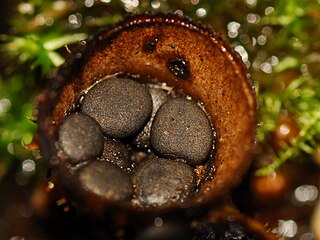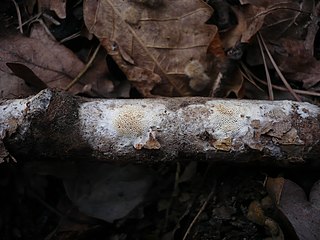
Copper fist is an N-terminal domain involved in copper-dependent DNA binding. It is named for its resemblance to a fist closed around a penny. Functionally, the "penny" is a collection of copper ions and the "knuckles" of the fist are proteins that interact with the promoter of the metallothionein gene, enhancing its transcription by creating a more stable binding site for RNA polymerase during transcription, an essential step in DNA replication.
In organic chemistry, a dicarboxylic acid is an organic compound containing two carboxyl groups. The general molecular formula for dicarboxylic acids can be written as HO2C−R−CO2H, where R can be aliphatic or aromatic. In general, dicarboxylic acids show similar chemical behavior and reactivity to monocarboxylic acids.
Lignin-modifying enzymes (LMEs) are various types of enzymes produced by fungi and bacteria that catalyze the breakdown of lignin, a biopolymer commonly found in the cell walls of plants. The terms ligninases and lignases are older names for the same class, but the name "lignin-modifying enzymes" is now preferred, given that these enzymes are not hydrolytic but rather oxidative by their enzymatic mechanisms. LMEs include peroxidases, such as lignin peroxidase, manganese peroxidase, versatile peroxidase, and many phenoloxidases of the laccase type.

Gloeoporus dichrous is a species of fungus in the family Irpicaceae. First described as Polyporus dichrous by Elias Magnus Fries in 1815, it was later transferred to the genus Gloeoporus by Italian mycologist Giacomo Bresadola in 1912. The variety G. dichrous var. niger was proposed in 2008, after molecular analysis revealed the two taxa were conspecific. G. dichrous is inedible.

Cyathus stercoreus, commonly known as the dung-loving bird's nest or the dung bird's nest, is a species of fungus in the genus Cyathus, family Nidulariaceae. Like other species in the Nidulariaceae, the fruiting bodies of C. stercoreus resemble tiny bird's nests filled with eggs. The fruiting bodies are referred to as splash cups, because they are developed to use the force of falling drops of water to dislodge and disperse their spores. The species has a worldwide distribution, and prefers growing on dung, or soil containing dung; the specific epithet is derived from the Latin word stercorarius, meaning "of dung".

Ceriporiopsis is a genus of fungi in the family Phanerochaetaceae. The genus is widely distributed, and, according to a 2008 estimate, contains about 25 species. Ceriporiopsis was circumscribed in 1963 by Polish mycologist Stanislaw Domanski. The genus is a wastebasket taxon, containing "species that share common macroscopic and microscopic characteristics, but are not necessarily related." Ceriporiopsis species are crust fungi that cause a white rot. They have a monomitic hyphal system, containing only generative hyphae, and these hyphae have clamp connections.

Ceriporia is a widely distributed genus of crust fungi.
Obba is a genus of three species of poroid, white rot crust fungi in the family Gelatoporiaceae. The genome sequence of the type species, O. rivulosa, was reported in 2016.
Ceriporiopsis pseudoplacenta is a species of poroid crust fungus in the family Phanerochaetaceae. It was described as a new species by mycologists Josef Vlasák and Leif Ryvarden in 2012. The type specimen was collected in Bogachiel State Park, Washington, where it was found growing on a coniferous log. It is named for its superficial similarity to Postia placenta.
Skeletocutis inflata is a species of poroid fungus in the family Polyporaceae. Found in Guangdong, China, it was described as a new species in 2013 by mycologist Bao-Kai Cui. The fungus is characterized by having fruit bodies with caps, and small pores numbering 8–10 per millimetre. Microscopically, it features inflated skeletal hyphae that partially dissolve in a solution of potassium hydroxide (KOH). The skeletal hyphae in the trama are parallel along the tubes.
Rickiopora is a fungal genus of unknown familial placement in the order Polyporales. The genus is monotypic, containing the single neotropical species Rickiopora latemarginata.
Ceriporiopsis kunmingensis is a species of poroid crust fungus in the family Phanerochaetaceae. It was described as a new species by mycologist Chang-Lin Zhao in 2016. The type specimen was collected in Yunnan, China, where it was found fruiting on a fallen angiosperm trunk. The colour of the fruit body is pale cinnamon-buff, becoming yellowish when dry. Spores of C. kunmingensis are sausage shaped (allantoid) and measure 4.5–5 by 1.5–2 μm. The fungus is closely related to Phlebia aurea, and groups phylogenetically with P. livida and P. subserialis.|
Niemelaea is a genus of poroid crust fungi in the family Meruliaceae. The genus was circumscribed by Russian mycologists in 2015 to contain three fungi formerly placed in the genus Ceriporiopsis. Niemelaea fungi are characterized by their crust-like fruit body, large, thin-walled angular pores, and a monomitic hyphal system. Spores made by these fungi are ellipsoid and have refractive contents. The genus is named in honour of Finnish mycologist and polypore specialist Tuomo Niemelä, who described the species Ceriporiopsis balaenae.
Skeletocutis friata is a rare species of poroid crust fungus in the family Polyporaceae. Found in Finland, it was first described as a new species in 1998 by Tuomo Niemelä and Reima Saarenoksa, with the name Skeletocutis friabilis. It was given the epithet friata three years later, after it was discovered that a tropical Asian species had already been given the name Skeletocutis friabilis, with a publication date two months prior to theirs. The holotype was collected by Saarenoksa in Sipoo, southern Finland, where it was found growing on the bark and exposed wood of a fallen twig of common alder. The authors later noted that subsequent searching of the type locality, as well as other locations in southern Finland, failed to turn up additional examples of this species.

The Irpicaceae are a family of mostly polypores and crust fungi in the order Polyporales.
Josef Herink was a Czech physician and mycologist.






